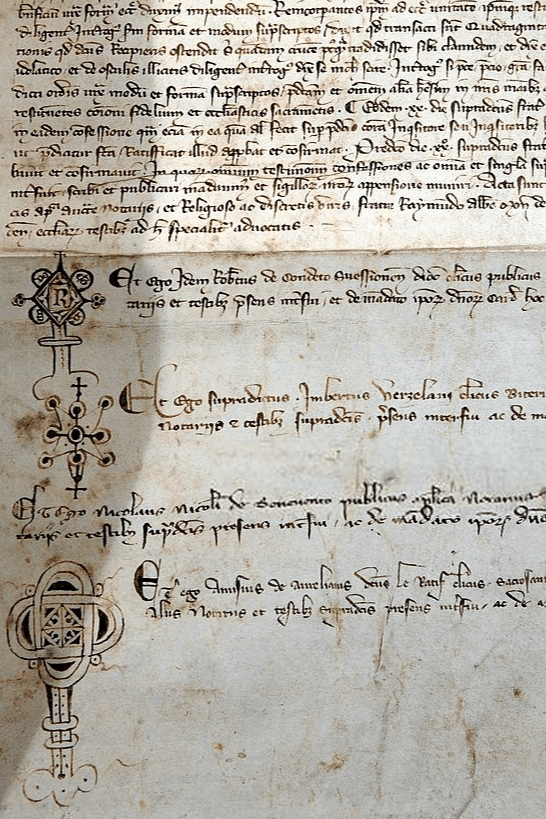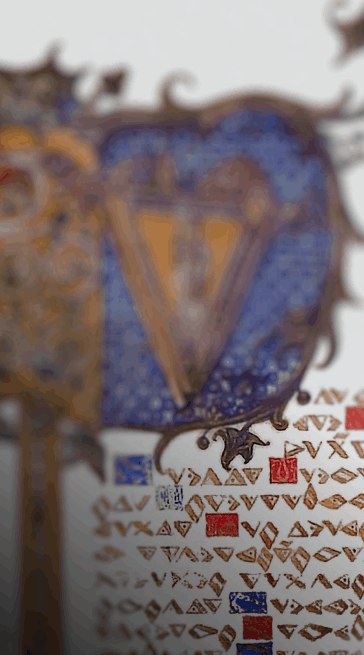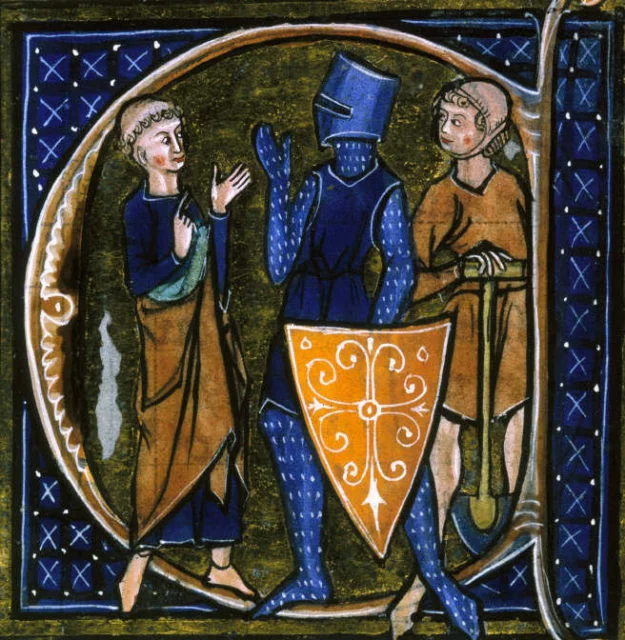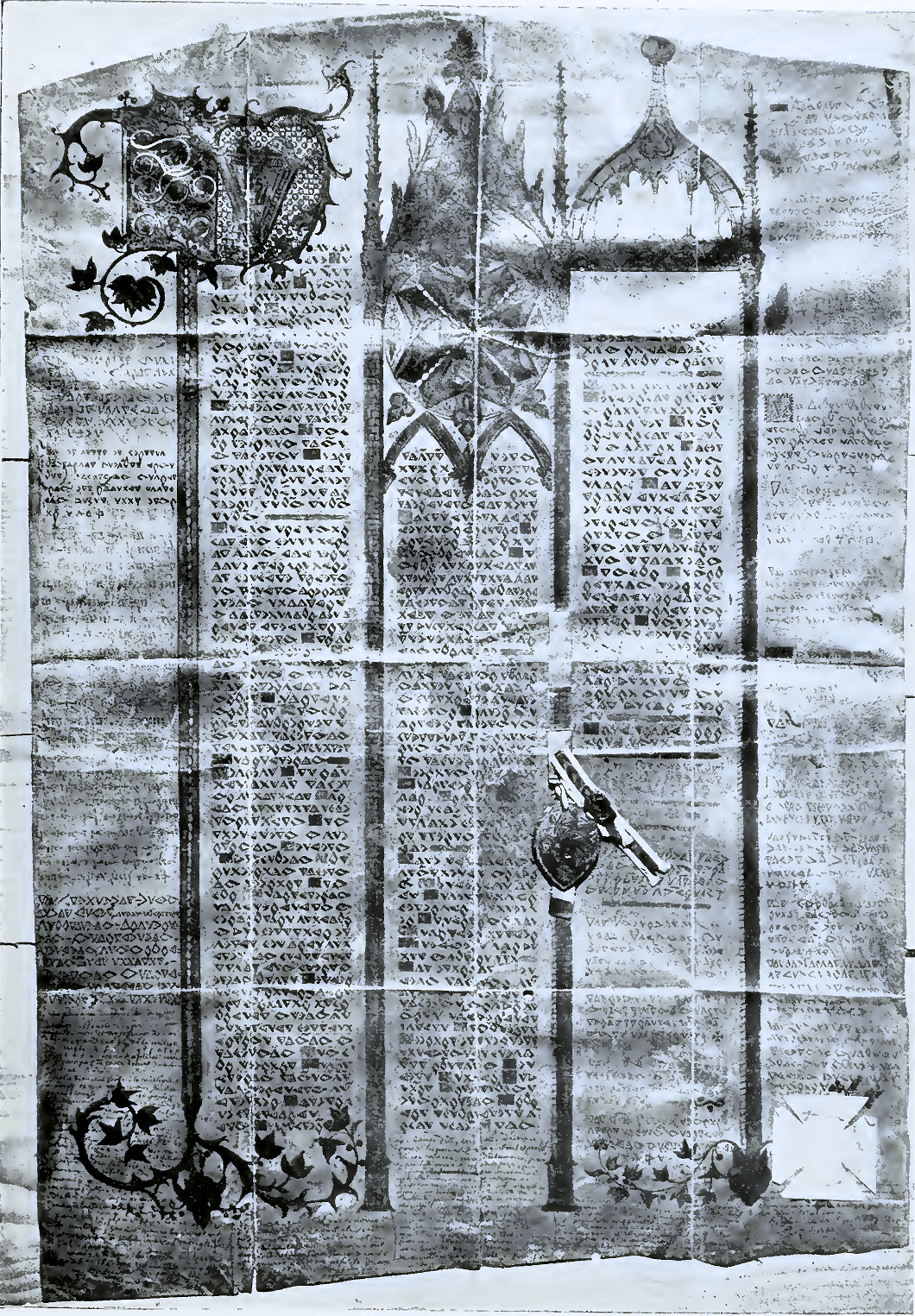The Latin Translation
Ego frater Johannes Marcus Larmenius, hyerosolimitanus, Dei gratia et secretissimo venerandi sanctissimique martyris, supremi templi militiæ magistri (cui honos et gloria) decreto, communi fratrum consilio confirmato, super universum templi ordinem, summo et supremo magisterio insignitus, singulis has decretales litteras visuris, salutem, salutem, salutem.
Notum sit omnibus tam præsentibus quam futuris, quod, deficientibus, propter extremam ætatem, viribus, rerum angustia et gubernaculi gravitate perpensis, ad majorem Dei gloriam, ordinis, fratrum et statutorum tutelam et salutem, ego supra dictus, humilis magister militiæ Templi, inter validiores manus supremum statuerim deponere magisterium:
Idcirco, Deo juvante, unoque supremi conventus equitum consensu, apud eminentem commendatorem et carissimum, Franciscum Thomam Theobaldum Alexandrinum, supremum ordinis templi magisterium, auctoritatem et privilegia contuli, et hoc præsenti decreto, pro vita, confero cum potestate, secundum temporis et rerum leges, fratri alteri, institutionis et ingenii nobilitate morumque honestate præstantissimo, summum et supremum ordinis templi magisterium, sine commilitonum templi conventus; et, rebus ita sese habentibus, succesor ad nutum eligatur.
Ne autem languescant supremi officii munera, sint nunc et perenniter quatuor supremi magistri vicarii; supremam potestatem, eminentiam et auctoritatem; super universum ordinem, salvo jure supremi magistri habentes; qui vicarii magistri apud seniores secundum professionis seriem eligantur. Quod statutum è commendato mihi et fratribus voto sacrosancti suprà dicto venerandi beatissimique magistri nostri, martyris (cui honos et gloria) amen.
Ego denique, fratrum supremi conventus decreto, è suprema mihi comissa auctoritate, Scotos Templarios ordinis desertores, anathemate percussas, illosque et fratres sancti Johannis hyerosolimae, dominiorum militiæ spoliatores (quibus apud Deum misericordia) extrà girum templi, nunc et in futurum, volo, dico et jubeo.
Signa, ideo, pseudo-fratribus, ignota et ignoscenda constitui, ore commilitonibus tradenda, et quo, in supremo conventu, jam tradere modo placuit. Quæ vero signa tantummodo pateant post debitam professionem et æquestrem consecrationem, secundùm templi commilitonum statuta, ritus et usus, suprà dicto eminenti commendatoris à me transmissa, sicut à venerando et sanctissimo martyre magistro Jacobo de Molaya (cui honos et gloria) in meas manus habui tradita. Fiat sicut dixi fiat. Amen.
Ego Johannes Marcus Larmenius dedi, Parisii die decima tertia februarii 1324.
Ego Franciscus Thomas Theobaldus Alexandrinus, Deo jurante, supremum magisterium acceptum habeo, 1324.
Ego Arnulphus De Braque, Deo juvante, supremum magisterium acceptum habeo, 1340.
Ego Joannes Claromontanus, Deo juvante, supremum magisterium acceptum habeo, 1349.
Ego Bertrandus Gueselin, Deo juvante, supremum magisterium acceptum habeo, 1357.
Ego Johannes Arminiacus, Deo juvante, supremum magisterium acceptum habeo, 1381.
Ego Bernardus Arminiacus, Deo juvante, supremum magisterium acceptum habeo, 1392.
Ego Johannes Arminiacus II, Deo juvante, supremum magisterium acceptum habeo, 1419.
Ego Johannes Croyus, Deo juvante, supremum magisterium acceptum habeo, 1451.
Ego Robertus Lenoncurtius, Deo juvante, supremum magisterium acceptum habeo, 1478.
Ego Galeas de Salazar, Deo juvante, supremum magisterium acceptum habeo, 1497.
Ego Philippus Chabotius, Deo juvante, supremum magisterium acceptum habeo, 1516.
Ego Gaspardus de Salciaco Tavanneusis, Deo juvante, supremum magisterium acceptum habeo, 1544.
Ego Henricus De Monte Morenciaco, Deo juvante, supremum magisterium acceptum habeo, 1574.
Ego Carolus Valesius , Deo juvante, supremum magisterium acceptum habeo, 1616.
Ego Jacobus Ruxellius de Granceio, Deo juvante, supremum magisterium acceptum habeo, 1651.
Ego Jacobus Henricus de Duroforti, dux de Duras, Deo jnvante, supremum magisterium acceptum habeo, 1681.
Ego Philippus, dux Aurelianensis, Deo juvanle, supremum magisterium acceptum habeo, 1705.
Ego Ludovicus.Augustus Borbonius, dux du Maine, Deo juvante, supremum magisterium acceptum habeo, 1724.
Ego Ludovicus Henricus Borbonius Condœus, Deo juvante, supremum magisterium acceptum habeo, 1737.
Ego Ludovicus Franciscus Borbonius Conty, Deo juvante, supremum magisterium acceptum habeo, 1741.
Ego Ludovicus Henricus Timoleo de Cossé-Brissac, Deo juvante, supremum magisterium acceptum habeo, 1776.
Ego Claudius Mathæus Radix de Chevillon templi senior vicarius magister, adstantibus fratribus prospere Maria Petro Michaele Charpentier de Sainiot, Bernardo Raymundo Fabré, templi vicariis magistris et Johanne Baptista de Courchant, supreme proeceptore , hasce litteras decretales à Ludovico Timoleone de Cossé-Brissac, supremo magistro, in temperibus infaustis mihi depositas, fratri Jacobo.Philippo Le Dru, templi seniori vicario magistro tradidi, ut istæ litteræ, in tempore opportuno, ad perpetuam ordinis nostri memoriam, juxtà ritum orientalem vigeant. Die decimâ junii 1804.
Ego Bernardus Raymundus Fabre, Deo juvante, supremum magisterium acceptum habeo , die quarta novembrii 1804.
Translation of "Charta Transmissionis"
I, Brother John Mark Larmenius, of Jerusalem, by the grace of God and the secret decree of the most venerable and holy martyr, the Grand Master of the Soldiery of the temple, to whom be all honor and glory, confirmed by the common council or the Brethren, being endowed with the Supreme Grand Mastership of the whole Order of the Temple, to everyone who shall see these Letters Decretal thrice greeting:
Be it known to all, both present and to come, that the failure of my strength, on amount of extreme age, my poverty, and the weight of government being well considered I, the aforesaid humble Master of the Soldiery of the temple, have determined, for the greater glory of God and the protection and safety of the Order, the Brethren, and the statutes, to resign the Grand Mastership into stronger hands.
On which account, God helping, and with the consent of a Supreme Convention of Knights, I have conferred and by the present decree do confer, for life, the authority and prerogatives of Grand Master of the Order of the Temple upon the Eminent Commander and very dear Brother, Francis Thomas Theobald Alexandrinus, with the power, according to time and circumstances, of conferring the Grand Mastership of the Order of the Temple and the supreme authority upon another Brother, most eminent for the nobility of his education and talent and decorum of his manners: which is done for the purpose of maintaining a perpetual succession of Grand Masters, an uninterrupted series of successors, and the integrity of the statutes. Nevertheless, I command that the Grand Mastership shall not be transmitted without the consent of a General Convention of the fellow-soldiers of the Temples as often as that Supreme Convention desires to be convened, and, matters being thus conducted, the successor shall be elected at the pleasure of the knights.
But, lest the powers of the supreme office should fall into decay, now and for ever let there be four Vicars of the Grand Master, possessing Supreme power, eminence, and authority over the whole Order, With the reservation of the rights of the Grand Master, which Vicars of the (Grand Masters shall be chosen from among the alders, according to the order of their profession. Which is decreed in according with the above-mentioned wish, commended to me and to the Brethren by our most venerable and most blessed Master, the martyr, to whom be honor and glory. Amen.
Finally, on consequence of a decree of a Supreme Convention of the Brethren, and by the supreme authority to me committed, I will, declare, and command that the Scottish exemplars, as deserters from the Order, are to be accursed, and that they and the brethren of Saint John of Jerusalem, upon whom may God have mercy, as spoliators of the domains of our soldiery are now and hereafter to be considered as beyond the pale of the Temple I have therefore established signs, unknown to our false Brethren, and not to be known by them, to be orally communicated to our fellow-soldiers, and in which way I have already been pleased to communicate them in the Supreme Convention.
But these signs are only to be made known after due profession and knightly consecrations according to the Statutes, Rites, and Usages of the fellow-soldiery of the Temple, transmitted by me to the above-named Eminent Commander as they there delivered into my hands by the venerable and most holy martyr, our Grand Master, to whom be honor and glory. Let it be done as I have said. So mote it be. Amen.
I, John Mark Larmenius, have done this on the thirteenth day of February, 1324.
I, Francis Thomas Theobaldus Alexandrinus, God helping, have accepted the Grand Mastership, 1324.
And then follow the acceptances and signatures of twenty-two succeeding Grand Masters-the last, Bernard Raymund Fabre, under the date of 1804.
First endorsement in French
"To the Greatest glory of God. Bernard Raymond, by the grace of God and the
suffrages of our brethren, Grand Master of the Knights of the Temple a, g, a, e, t, y, t, p, e, t, e, p, s, s, u, t, d, f, m, Jean Baptiste Auguste d'Europe (de Courchant) Lieutenant General. S-S-S. "
"Our well-beloved brothers
, The multiplicity of the duties which we have for long imposed on ourself (the relief of the sick) and no longer being able to permit ourselves any distraction, and even finding it impossible in future to give ourselves to the supreme direction of the Temple, we have resolved to renounce our command, and to abdicate the Mastership in order to place ourselves in the ranks of the soldiers, and serve with the Knights and give in our turn an example of obedience. But, that the Temple may not cease to be governed by an uninterupted line of lawful princes, and seeing that v. a. e. is the only Prince of the order who has not renounced the authority with which he had been invested by sacred rites, trusting besides to the great virtues which have gained for you the veneration, the trust, and the affection of our brothers, it is into your hands that we must and ought to commit the magisterial and pontifical power.
For this cause, we declare by these presents that from this day we abdicate the sovereign power, we renounce the command of the knights. That we declare the depository of the full patriarchal authority and the magisterial Power, the person of v. a. e. J. B. until such time as the Order shall have given us a successor according to our constitution, you shall surrender to the said successor the sovereign powers which you hold from us and which we transmit to you by the formal deed of our sovereign will in the same manner as we received them on our attainment to the sovereignty of the Order. Nothing remains but to pray God to have you in his benediction.
Given at Paris in our magisterial palace the 17th cisten and the year of the Order 694 and the 9th of our Mastership :
21st of November 1812 of
N.S.J.C. Vive Dieu et Amour.
The Grand Master, Sovereign Pontiff & Patriarch F. Bernard Raymond."
On the back of the Charter is the second endorsement in French
"To the Glory of God in the Highest
"
Bernard Raymond
"By the Grace of God, and the votes of our brothers. Grand Master of the Knights of
the Temple, to all those who shall see these letters present S.S.S. Having perused the letter written to us by our well-beloved and most faithful brother the prince of the Order Jean Baptiste Auguste d'Europe (de Courchant) our lieutenant-general, taking into consideration the weighty arguments by which this illustrious Templar urges us to resume the government of the knights, full of the desire to give this worthy and well beloved Prince, and all our worthy and well beloved knights our emphatic proof of devotion to the cause of the Temple—putting away from us in consequence all personal motives, we are willing since the welfare of the body public exacts from us this sacrifice, to withdraw and annul as we shall withdraw and treat as nought by these presents all resignation of the Grand Mastership, which we have been able to give, and we resume the patriarchal authority and the magisterial power + knowing the great wisdom characterising the very high and very excellent prince and most serene lord Jean Baptiste Auguste d'Europe we will that this illustrious brother be and remain our legate in accordance with Chapter X of the statutes, and that he exercise in this capacity absolute power until the imperative reasons which at present prevent us from administration leave us leisure to relieve this prince of the cares necessarily attached to the heavy duties with which we
have invested him , and with which we invest him anew in virtue of these presents. + Fiat sicafc jussimus et jubernus. Amen.
Given in Paris iu our magisterial palace the 16th Thebeth 649 9th year of our mastership:
19 December 1812 de N. S. T. C.
The Gd. Master, Sovereign Pontiff and Patriarch.
F. Bernard Raymond."



